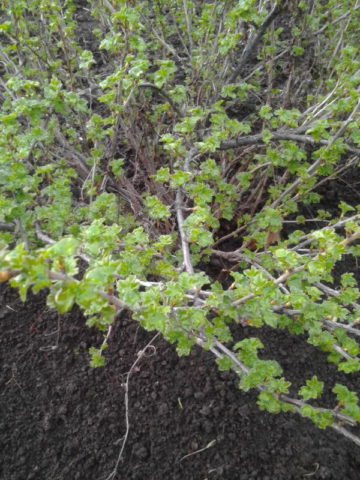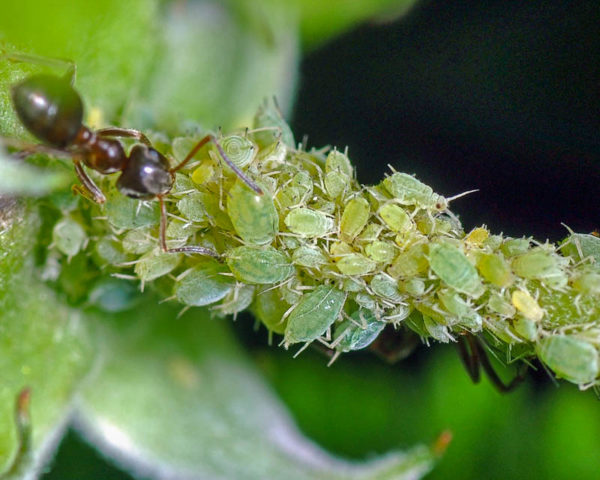Content
Gooseberry Serenade is popular among amateur gardeners. The absence of thorns on the shoots makes caring for the bush easy and convenient. The variety has many supporters, but there are also opponents of growing a thornless bush. A detailed acquaintance with the Serenade gooseberry will help you make your choice.
Description of Gooseberry Serenade
Gooseberry Serenade was created by crossing the Besshipny and Kaptivator varieties at the V.N. I. V. Michurin. Forms a vigorous, slightly spreading bush, a crown of medium thickening. Shoots are strong, curved, prickling is poorly expressed. Single thorns are mainly concentrated in the lower part of the bush. Leaves are light, convex, dense. The surface of the sheet is smooth, without coarse veins. The berries are medium, pear-shaped, plum-colored, not pubescent, with a small number of seeds. The recommended growing region is the Central Black Earth Region.
Drought resistance, frost resistance
The Serenada gooseberry is classified as drought-resistant. Lignified shoots can easily tolerate frosts down to -40 ° C. There is a high resistance to frost up to -30 ° C of fruit buds.
Fruiting, productivity
The berries on the bush are medium and large, with a smooth surface and a light waxy bloom. There are few seeds in the berries. The skin is dense, plum-colored with pink veins. The taste is sweet and sour, dessert. The ripening period is extended, ripe berries are intensely colored. Ripen in late July or early August. Average yield per bush 3-5 kg. Produces well without pollinating companions.
The bushes are suitable for industrial cultivation. Berries for universal use, tolerate transportation normally.
The variety is not prone to shedding. In excessively dry and hot years, the bushes require shading to avoid baking wine-colored berries.
Advantages and disadvantages
The Serenade gooseberry variety is prized by farmers for a number of reasons:
- high winter hardiness and drought resistance;
- weak shoots studding;
- good transportability of fruits;
- powdery mildew resistance.
Like any other type of gooseberry, it does not tolerate sudden changes in temperature during the flowering period.
Breeding features
Propagation of gooseberry seeds is not the preferred method due to the high labor intensity. Such bushes begin to bear fruit in the 4-5 year of planting.
Weakly spiked gooseberries reproduce best of all:
- dividing the mother bush in half;
- horizontal layering from 3-4-year-old bushes;
- vertical layering through intense rejuvenation;
- by grafting with half woody cuttings.
To obtain a plant with a high degree of varietal purity, it is recommended to buy the first seedling in a specialized nursery.
Planting and leaving
Gooseberry seedlings successfully take root only after transplanting during the period of cold snap and leaf fall. It is recommended to plant a cutting in a new place after the leaves have completely fallen from the bush, at an air temperature of + 8-10 ° C. For planting, choose strong 1-2-year-old seedlings with a developed root system and shoots in the woody stage.
Gooseberries are picky about sunlight. In areas with intense darkening, the yield of the bush decreases, the berries become smaller, the variety degenerates. The gooseberry does not tolerate waterlogging at all. With a high occurrence of groundwater, the root system begins to rot, the shoots quickly dry out. For the same reason, gooseberries do not like heavy clay soils.
A pit for planting gooseberries is prepared in advance, 5-7 days in advance, so that the earth has time to settle. The dimensions of the pit are 50x50x50 cm. The upper fertile layer is removed and enriched with a nutritious composition. The mixture includes:
- 1 bucket of compost;
- 50 g of potassium sulfate;
- 50 g superphosphate.
If the soil on the site is clay, add 5 kg of sand.
The landing algorithm is simple:
- The fertile layer is laid at the bottom of the planting pit, half is left for compaction.
- The seedling is placed in a pit, the root system is straightened.
- A young bush is sprinkled, the root collar is buried 4-5 cm below the ground level.
- The earth is compacted and abundantly watered with water, mulched with straw, with a layer of 3-5 cm.
- The shoots are pruned, leaving a segment 50-60 cm long with 5-7 buds.
The bushes are planted at a distance of 0.5 m from each other.
Growing rules
The rules of gooseberry farming are simple and will not cause difficulties for novice gardeners.
The gooseberry root system is located close to the soil surface, at a depth of no more than 7 cm, and is extremely in need of oxygen. Every spring, soil is loosened and fertilized with potassium-nitrogen fertilizers or manure infusion in a ratio of 1 part of fresh manure to 8 parts of water. After tilling, the soil around the bush is mulched with new straw.
Gooseberry is a drought-resistant plant, but it needs additional watering during flowering and fruit ripening. The organization of drip irrigation is considered preferable. If this is not possible, 20-25 liters of warm water are poured under one bush twice a season. Gooseberry does not tolerate sprinkling and direct filling of the root collar.
The first cuttings of gooseberries are aimed at shaping the shape of a bush and laying fruit-bearing branches. To do this, leave 4-6 of the strongest shoots coming from the root, the rest are removed. From 3-4 years, the main purpose of pruning is sanitary thinning of the bush. Formation is carried out in early spring or late autumn during dormant periods. Intensive rejuvenating pruning is performed at the age of 9-10 years. In late autumn, without exception, all old lignified shoots are removed. Leave new vegetative buds at the root.
For the winter, it is recommended to cover the gooseberry to protect it from rodents (hares, mice) and prevent freezing. They do it like this:
- Plentiful charging watering is carried out 2-3 days before the shelter.
- The branches are tied with twine and pulled together in one bundle.
- The bush is slightly pressed to the ground with both hands.
- Cover the branches with burlap and cover with earth, with a layer of 7-10 cm.
- They are covered with spruce branches, and snow is raked up in snowfalls.
In mid-April or early May, the bushes are opened and abundant watering is carried out, loosened, fertilized, mulch.
Pests and diseases
Gooseberry Serenade is not affected by powdery mildew. Sometimes the variety is affected by other fungal diseases: anthracnose, goblet rust and mosaic. At the first sign, diseased branches from the bushes are removed and burned. The plant is treated with nitrophene, copper sulfate, Bordeaux liquid. Spraying is carried out twice, with an interval of 10 days.
The cause of the appearance of fungal diseases in the berry stands is the excessive thickening of the crown and a large number of weeds. During humid hot periods in such an environment, fungal spores multiply intensively and quickly destroy perennial plantings.Continuous weed control will be a good preventive disease control measure.
The biggest problems for gooseberries are:
- moth butterfly - with the beginning of flowering, it lays eggs on the leaves, subsequently the caterpillars eat the berries.
- shoot aphid - in the process of life, it twists the gooseberry leaves, thinns the shoots, causes the green berries to fall off.
Insects are destroyed with Actellik and Fufanon insecticides. As a preventive measure, at the end of flowering, the bushes are sprayed with Bicol.
Conclusion
A detailed description of the Serenade gooseberry with a photo and care instructions shows all the benefits of the variety. Gooseberry Serenade is undemanding to care, has strong immunity to powdery mildew and gives a good harvest of tasty berries. Choosing the Serenade gooseberry is recommended for those who plant berry bushes in large quantities for their own consumption and sale.












